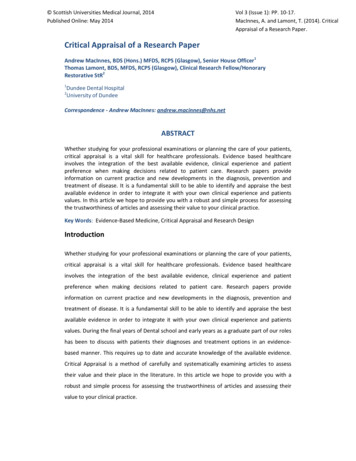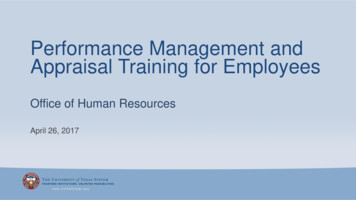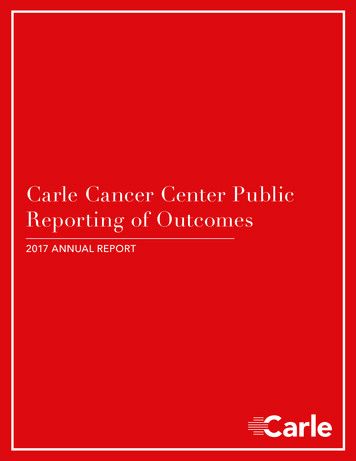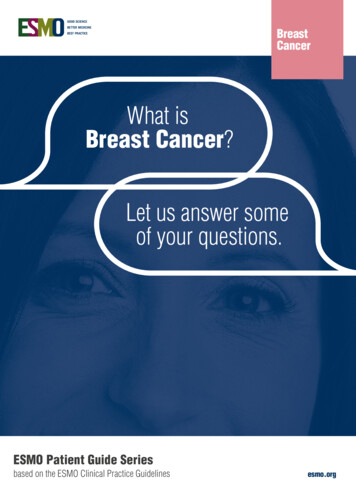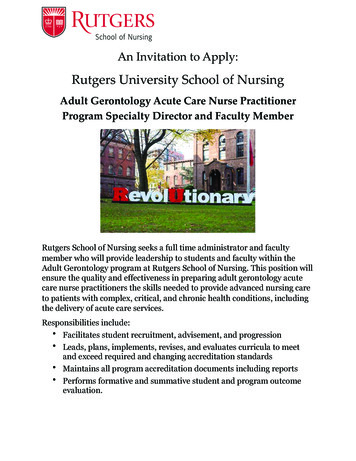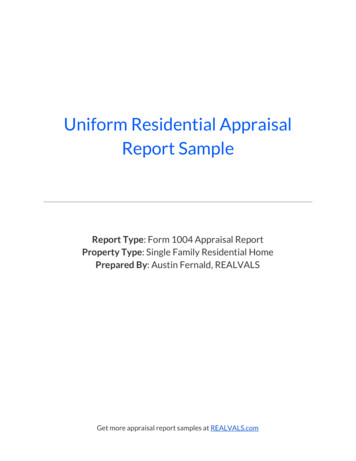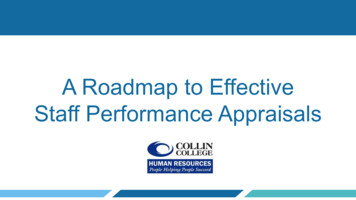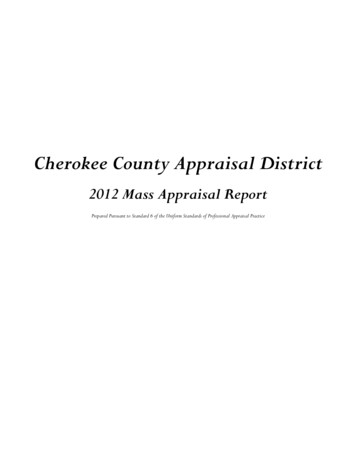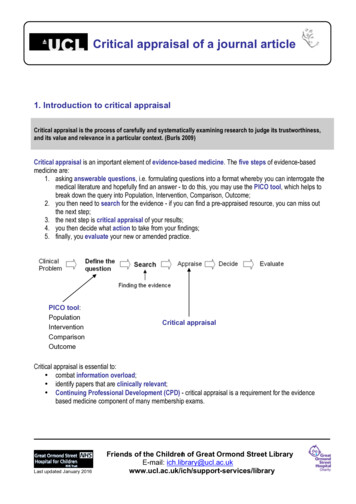
Transcription
Critical appraisal of a journal article1. Introduction to critical appraisalCritical appraisal is the process of carefully and systematically examining research to judge its trustworthiness,and its value and relevance in a particular context. (Burls 2009)Critical appraisal is an important element of evidence-based medicine. The five steps of evidence-basedmedicine are:1. asking answerable questions, i.e. formulating questions into a format whereby you can interrogate themedical literature and hopefully find an answer - to do this, you may use the PICO tool, which helps tobreak down the query into Population, Intervention, Comparison, Outcome;2. you then need to search for the evidence - if you can find a pre-appraised resource, you can miss outthe next step;3. the next step is critical appraisal of your results;4. you then decide what action to take from your findings;5. finally, you evaluate your new or amended practice.PICO al appraisalCritical appraisal is essential to:UCLinformationLibrary overload; combatServices identifypapers that are clinically relevant; Continuing Professional Development (CPD) - critical appraisal is a requirement for the evidencebased medicine component of many membership exams.Last updated January 2016Friends of the Children1 of Great Ormond Street LibraryE-mail: vices/library
2. Location and selection of studies2.1. Bad scienceWe often come across news articles making unjustified scientific/medical claims. For example, in June 2008 theSunday Express published an article about the link between suicides and phone masts:The spate of deaths among young people in Britain’s suicide capital could be linked to radio waves from dozens ofmobile phone transmitter masts near the victims’ homes.Dr Roger Coghill, who sits on a Government advisory committee on mobile radiation, has discovered that all 22youngsters who have killed themselves in Bridgend, South Wales, over the past 18 months lived far closer thanaverage to a mast. (Johnston 2008)Ben Goldacre, a medical doctor and author of the weekly Bad Science column in the Guardian, investigatedthe claim made by the Sunday Express article and found out the following:I contacted Dr Coghill, since his work is now a matter of great public concern, and it is vital his evidence can beproperly assessed. He was unable to give me the data. No paper has been published. He himself would notdescribe the work as a “study”. There are no statistics presented on it, and I cannot see the raw figures. In fact DrCoghill tells me he has lost the figures. Despite its potentially massive public health importance, Dr Coghill is sadlyunable to make his material assessable. (Goldacre 2008)2.2. Behind the headlinesThe article about the link between suicides and phone masts is an example of the way in which ‘bad science’can make it to the headlines. Sometimes, however, science/health stories found in the news are genuinelybased on valid studies, but jump to wrong conclusions by failing to consider some important aspects, such asthe study design and the level of evidence of the original research.For instance, in July 2008 an article was published on the Daily Mail claiming that there is a link betweenvegetarian diet and infertility (Daily Mail Reporter 2008). The article was based on a cross-sectional study onsoy food intake and semen quality published in the medical journal Human Reproduction (Chavarro et al. 2008).Behind the Headlines, a NHS service providing an unbiased daily analysis of the science behind the healthstories that make the news, issued the following comment:The Daily Mail today reports on, “Why a vegetarian diet may leave a man less fertile.” It said research has foundthat eating tofu can significantly lower your sperm count.The study behind this news had some limitations: it was small, and mainly looked at overweight or obese men whohad presented to a fertility clinic. It focused only on soy (soya) intake, and the Daily Mail’s claim that there is acausal link between eating a ‘vegetarian diet’ and reduced fertility is misleading. (NHS Knowledge Service 2008)2.3. Bias in the location and selection of studiesPerhaps it is not surprising that the study on soy and infertility received some publicity - but if the study had notobtained positive results, would it have been published - and quoted in the news?When reviewing the literature published in scientific/medical journals, we should consider that papers withsignificant positive results are more likely to be:Last updated January 2016Friends of the Children2 of Great Ormond Street LibraryE-mail: vices/library
submitted and accepted for publication (publication bias);published in a major journal written in English (Tower of Babel bias);published in a journal indexed in a literature database, especially in less developed countries (databasebias);cited by other authors (citation bias);published repeatedly (multiple publication bias); and quoted by newspapers!(Egger & Smith 1998; Gregoire, Derderian, & Le Lorier 1995)3. Study designThe following lists summarise the most common types of study design found in the medical literature.3.1. Qualitative studiesQualitative studies explore and understand people's beliefs, experiences, attitudes, behaviour andinteractions. They generate non-numerical data. Examples of qualitative studies: Document - study of documentary accounts of events, such as meetings; Passive observation - systematic watching of behaviour and talk in natural occurring settings; Participant observation - observation in which the researcher also occupies a role or part in thesetting, in addition to observing; In depth interview - face to face conversation with the purpose of exploring issues or topics in detail.Does not use preset questions, but is shaped by a defined set of topics; Focus group - method of group interview which explicitly includes and uses the group interaction togenerate data. (Greenhalgh 2001)3.2. Quantitative studiesQuantitative studies generate numerical data or data that can be converted into numbers. Examples ofquantitative studies: Case report - report on a single patient; Case series - report on a series of patients (no control group); Case control study - identifies patients with a particular outcome (cases) and control patients withoutthe outcome. Looks back and explores exposures and possible links to outcome. Very useful incausation research; Cohort study - identifies two groups (cohorts) of patients one which received the exposure of interest,and one which did not. Follows these cohorts forward for the outcome of interest. Very useful incausation as well as prognosis research.(Bandolier 2004)Key quantitative studies: Randomized Controlled Trial (RCT) - a clinical trial in which participants are randomly allocated to atest treatment and a control; involves concurrent enrolment and follow-up of both groups; gold standardin testing the efficacy of an intervention (therapy/prevention); Systematic review - identifies and critically appraises all research on a specific topic, and combinesvalid studies; increasingly important in evidence based medicine; different from review article (which isa summary of more than one paper on a specific topic, and which may or may not be comprehensive);Last updated January 2016Friends of the Children3 of Great Ormond Street LibraryE-mail: vices/library
Meta-analysis - a systematic review that uses quantitative methods to summarise the results.(Bandolier 2004; NCBI 2010)The following diagram shows a model for the organisation of some quantitative studies. Different types of studiesare located at different levels of the hierarchy of evidence. All types of studies may be found published injournals, with the exception of the top two nopses, othersyntheses of evidence(preappraised)Systematic reviews /meta-analysesRandomised controlledtrials (RCTs)Primaryresearch(notappraised)Found injournalsCohort studies, case control studies,case series / reportsExpert opinion, editorials, reviewarticles, laboratory studiesAdapted from (Haynes 2006).There are also other types of quantitative studies, such as: Cross-sectional survey - the observation of a defined population at a single point in time or timeinterval. Exposure and outcome are determined simultaneously. Gold standard in diagnosis andscreening research; Decision analysis - uses the results of primary studies to generate probability trees to be used inmaking choices about clinical management or resource allocation; Economic analysis - uses the results of primary studies to say whether a particular course of action isa good use of resources.(Bandolier 2004; Greenhalgh 2001)3.3. Critical appraisal of different study designsTo critically appraise a journal article, you would have to start by assessing the research methods used in thestudy. This is done using checklists which are specific to the study design. The following checklists arecommonly used: CASP f8 SIGN guideline developer’s handbook http://www.sign.ac.uk/methodology/checklists.html CEBMH http://www.cebm.net/critical-appraisal/Last updated January 2016Friends of the Children4 of Great Ormond Street LibraryE-mail: vices/library
4. Randomised Controlled Trials (RCTs)4.1. Mechanisms to control bias in RCTsRCTs control bias by randomisation and blinding.Randomisation indicates that participants are randomly allocated to treatment or control group. Acceptable methods of randomisation include random numbers, either from tables or computergenerated (for more details see Schulz & Grimes 2002). Unacceptable methods include last digit of date of birth, date seen in clinic etc. (for more details seeStewart & Parmar 1996). Stratified randomisation is often used to avoid confounding factors, i.e. to ensure equal distributionof participants with a characteristic thought to affect prognosis or response.Blinding means masking who is getting treatment and control. Single blinding: participants do not know. Double blinding: neither the participants nor those giving the intervention know. Triple blinding: statisticians doing the analysis also do not know.The following diagram illustrates the sources of bias in RCTs:(Greenhalgh 2001)Last updated January 2016Friends of the Children5 of Great Ormond Street LibraryE-mail: vices/library
4.2. Advantages and disadvantages of RCTsAdvantages: allow for rigorous evaluation of a single variable; potentially eradicate bias; allow for meta-analysis.Disadvantages: expensive; time consuming; ethically problematic at times - a trial is sometimes stopped early if dramatic effects are seen.4.3. Preliminary statistical concepts in RCTsBaseline characteristics - both the control and the intervention group should be broadly similar in factors likeage, sex distribution and level of illness.Sample size calculation (Power calculation) - a trial should be big enough to have a high chance of detecting aworthwhile effect if it exists. Statisticians can work out before the trial begins how large the sample size should bein order to have a good chance of detecting a true difference between the intervention and control groups(Greenhalgh 2001). Standard power: 80%.Intention to treat - all data on participants including those who withdraw from the trial should be analysed. Failureto do so may lead to underestimation/overestimation of results (Hollis & Campbell 1999).4.4. Presenting the results of RCTsP-valueP-value - the p-value refers to the probability that any particular outcome would have arisen by chance. A p-valueof Couldless thanthe1 inresult20 (p 0.05)statistically significant.haveis occurredby chance?The result is unlikely to bedue to chanceThe result is likelyto be due to chance10p 0.05a statisticallysignificant resultp 0.05not a statisticallysignificant resultp 0.051 in 20, therefore result fairlyunlikely to be due to chancep 0.001p 0.05p 0.5p 0.75very unlikelyunlikelyfairly likelyvery likely1 in 10001 in 201 in 23 in 4UCL LibraryConfidenceinterval - the same trial repeated hundreds of times would not yield the same results every time. ButServiceson average the results would be within a certain range. A 95% confidence interval means that there is a 95%chance that the true size of effect will lie within this range.Last updated January 2016Friends of the Children6 of Great Ormond Street LibraryE-mail: vices/library
reflection of the actual effect?§ The shorter the CI the more certain we can beExperimental resultRange within which the true size of effect lies within a given degree ofassurance (usually 95%)UCL Library4.5. QuantifyingServices the risk of benefit/harm in RCTsExperimental Event Rate (EER) - in the treatment group, number of patients with outcome divided by totalnumber of patients.Control Event Rate (CER) - in the control group, number of patients with outcome divided by total number ofpatients.Relative Risk or Risk Ratio (RR) - the risk of the outcome occurring in the intervention group compared with thecontrol group.RR EER/CERAbsolute Risk Reduction or increase (ARR) - absolute amount by which the intervention reduces (or increases)the risk of outcome.ARR CER-EERRelative Risk Reduction or increase (RRR) - amount by which the risk of outcome is reduced (or increased) inthe intervention group compared with the control group.RRR ARR/CEROdds of outcome - in each patient group, the number of patients with an outcome divided by the number ofpatients without the outcome.Odds ratio - odds of outcome in treatment group divided by odds of outcome in control group.If the outcome is negative, an effective treatment will have an odds ratio 1;If the outcome is positive, an effective treatment will have an odds ratio 1.(In case control studies, the odds ratio refers to the odds in favour of exposure to a particular factor in casesdivided by the odds in favour of exposure in controls).Number needed to treat (NNT) - how many patients need to have the intervention in order to prevent one personhaving the unwanted outcome.NNT 1/ARRIdeal NNT 1;The higher the NNT, the less effective the treatment.4.6. Critical appraisal of RCTsFactors to look for: allocation (randomisation, stratification, confounders); blinding;Last updated January 2016Friends of the Children7 of Great Ormond Street LibraryE-mail: vices/library
follow up of participants (intention to treat);data collection (bias);sample size (power calculation);presentation of results (clear, precise);applicability to local population.5. Systematic reviews5.1. Mechanisms to control bias in systematic reviewsSystematic reviews provide an overview of all primary studies on a topic and try to obtain an overall picture of theresults.To avoid bias, systematic reviews must: contain a statement of objectives, materials and methods; follow an explicit and reproducible methodology (Greenhalgh 2001).In a systematic review, all the primary studies identified are critically appraised and only the best ones areselected. A meta-analysis (i.e. a statistical analysis) of the results from selected studies may be included.5.2. Blobbogram/Forrest plotA blobbogram or forest plot is a graphical display used to present the result of a meta-analysis.Selected studies must be tested for homogeneity, which should be 50%. A quick way to check for homogeneityis to look at the confidence intervals for each study - if they don’t overlap, the studies are likely to beheterogeneous. More rigorous tests of homogeneity include χ2.If studies are homogeneous, a fixed-effect model is normally used in the meta-analysis. This means that resultsare only interpreted within the populations/samples in the included studies.If studies are heterogeneous, a random-effects model is used. This means that results are interpreted acrossthe wider population. A different underlying effect is assumed for each study and an additional source of variationis added to the model.Line of no effectBest/point estimateLargest studyConfidence IntervalSmallest studyResult of meta-analysisless of outcomesUCL LibraryServicesLast updated January 20161 (ratios)or0 (means)more of outcomesFriends of the Children8 of Great Ormond Street LibraryE-mail: vices/library
5.3. Advantages and disadvantages of systematic reviewsAdvantages: allow for rigorous pooling of results; may increase overall confidence from small studies; potentially eradicate bias; may be updated if new evidence becomes available; may have the final say on a clinical query; may identify areas where more research is needed.Disadvantages: expensive; time consuming; may be affected by publication bias - a test called Funnel Plot can be used to test for publication bias; normally summarise evidence up to two years before (due to the time required for the execution of thesystematic review).5.4. Critical appraisal of systematic reviewsFactors to look for: literature search (did it include published and unpublished materials as well as non-English languagestudies? Was personal contact with experts sought?); quality-control of studies included (type of study; scoring system used to rate studies; analysis performedby at least two experts); homogeneity of studies; presentation of results (clear, precise); applicability to local population.6. Where next?You could set up an evidence-based journal club: choose a topic of interest in your group; one person performs a literature search and finds a paper to bring to the meeting; the paper is presented in the meeting, and the literature search is also explained; appraise the paper as a group.Last updated January 2016Friends of the Children9 of Great Ormond Street LibraryE-mail: vices/library
7. Further information, support and training7.1. Further readingA number of books and journal articles have been written on critical appraisal. A good summary is provided byGuyatt & American Medical Association (2008):Guyatt, G. & American Medical Association. 2008, Users' guides to the medical literature : a manual for evidencebased clinical practice / edited by Gordon Guyatt . [et. al.] McGraw Hill Medical ; JAMA & Archives Journals.Hollands, H. & Kertes, P. J. 2010, "Measuring the size of a treatment effect: relative risk reduction, absolute riskreduction, and number needed to treat", Evidence-Based Ophthalmology, vol. 11, no. 4, pp. 190-194.7.2. Online resourcesLIBRARY CRITICAL APPRAISAL PAGE ry/services and facilities/training/critical-appraisalAGREE - http://www.agreetrust.org/AGREE is an international collaboration of researchers and policy makers who seek to improve the quality andeffectiveness of clinical practice guidelines by establishing a shared framework for their development, reportingand assessment. The website contains the ‘Agree Instrument’ which provides a framework for assessing thequality of clinical practice guidelines.Alberta University Evidence Based Medicine Toolkit - http://www.ebm.med.ualberta.ca/This is a collection of tools for identifying, assessing and applying relevant evidence for better health caredecision-making. The appraisal tools are adapted from the Users' Guides series prepared by the Evidence BasedMedicine Working Group and originally published in JAMA. It includes a glossary.CASP - http://www.casp-uk.net/The Critical Appraisal Skills Programme (CASP) aims to enable individuals to develop the skills to find and makesense of research evidence. The website gives access to critical appraisal checklists which guide the appraisal ofdifferent types of study.CATwalk - http://guides.library.ualberta.ca/catwalkThis site has been designed to assist University of Alberta medical residents in the process of completing aCritically Appraised Topic (CAT).CEBMH - http://www.cebm.net/critical-appraisal/Another useful source of guidelines by the Centre for Evidence-Based Mental Health.Centre for Evidence Based Medicine - http://www.cebm.netThe Centre for Evidence Based Medicine is the first of several centres around the country whose broad aim is topromote evidence-based health care and provide support and resources to anyone who wants to make use ofthem. It includes a wide range of EBM resources including critical appraisal tools.Dr Chris Cates’ EBM Website - www.nntonline.netProvides help with statistics.Last updated January 2016Friends of the Children10 of Great Ormond Street LibraryE-mail: vices/library
CLIST Resources for Critical Appraisal - oolkit/resources-for-critical-appraisalProvides links to critical appraisal resource pages maintained by a selection of UK healthcare libraries.The Little Handbook of Statistical Practice - http://www.tufts.edu/ gdallal/LHSP.HTMProvides help with statistics.How to read a paper - lications/how-read-paper Links tothe series of articles that make up the book ‘How to read a paper’. The articles are available online free of chargefrom the BMJ website.New Zealand Guidelines Group - http://www.nzgg.org.nzThe NZGG exists to promote effective delivery of health and disability services, based on evidence. The webpagecontains critical appraisal tools and guidance (under ‘Evidence Resources’).SCHARR - https://www.sheffield.ac.uk/scharrThe School of Health and Related Research at the University of Sheffield links to useful web resources.SIGN - .htmlThe guideline developer’s handbook by the Scottish Intercollegiate Guidelines Network is a useful source ofguidelines.University of Glasgow General Practice & Primary Care – Evidence Based Practice imarycare/ebp/#d.en.19511Useful collection of materials to help develop and practise the skills of critical appraisal, including checklists,‘jargon busters’ to explain the terminology and worked examples. A list of other evidence-based practice sites isalso included.7.3. The LibraryThe Library offers training and support in a range of information skills on a group or individual basis. We can trainyou in the Library or in your workplace. Please contact:Please see our website for more ces/library/services and facilities/trainingLast updated January 2016Friends of the Children11 of Great Ormond Street LibraryE-mail: vices/library
ReferencesBandolier. Glossary index. Bandolier . 2004.Web/URL: ml Accessed January 2016.Burls, A. What is critical appraisal? 2009. London, Hayward Group.Web/URL: raisal/ Accessed October 2010.Chavarro, J. E., Toth, T. L., Sadio, S. M., & Hauser, R. 2008, "Soy food and isoflavone intake in relation to semenquality parameters among men from an infertility clinic", Human Reproduction, vol. 23, no. 11, pp. 2584-2590.Daily Mail Reporter. Why a vegetarian diet may leave a man less fertile. Daily Mail , 5. 24-7-2008.Web/URL: U5fn1 Accessed January 2016.Egger, M. & Smith, G. D. 1998, "Bias in location and selection of studies", BMJ, vol. 316, no. 7124, pp. 61-66.Goldacre, B. Bad science: Suicides, Aids, and a masts campaigner. The Guardian , 12. 28-6-2008.Web/URL: 8/sciencenews.mobilephones Accessed January2016.Greenhalgh, T. 2014, How to read a paper : the basics of evidence based medicine, 5th ed. / Trisha GreenhalghBMJ Books.Gregoire, G., Derderian, F., & Le Lorier, J. 1995, "Selecting the language of the publications included in a metaanalysis: is there a Tower of Babel bias?", Journal of Clinical Epidemiology, vol. 48, no. 1, pp. 159-163.Guyatt, G. & American Medical Association. 2008, Users' guides to the medical literature : a manual for evidencebased clinical practice / edited by Gordon Guyatt . [et. al.] McGraw Hill Medical ; JAMA & Archives Journals.Haynes, R. B. 2006, "Of studies, syntheses, synopses, summaries, and systems: the "5S" evolution of informationservices for evidence-based healthcare decisions", Evidence-Based Medicine, vol. 11, no. 6, pp. 162-164.Hollands, H. & Kertes, P. J. 2010, "Measuring the size of a treatment effect: relative risk reduction, absolute riskreduction, and number needed to treat", Evidence-Based Ophthalmology, vol. 11, no. 4, pp. 190-194.Hollis, S. & Campbell, F. 1999, "What is meant by intention to treat analysis? Survey of published randomisedcontrolled trials", BMJ, vol. 319, no. 7211, pp. 670-674.Jadad, A. R., Moore, R. A., Carroll, D., Jenkinson, C., Reynolds, D. J. M., Gavaghan, D. J., & Mcquay, H. J. 1996,"Assessing the quality of reports of randomized clinical trials: Is blinding necessary?", Controlled Clinical Trials,vol. 17, no. 1, pp. 1-12.Johnston, L. Suicides 'linked to phone masts'. Sunday Express , 1. 22-6-2008.Web/URL: uicides-linked-to-phone-masts- Accessed January 2016.Last updated January 2016Friends of the Children12 of Great Ormond Street LibraryE-mail: vices/library
NCBI. MeSH. MeSH Database . 2010.Web/URL: http://www.ncbi.nlm.nih.gov/mesh Accessed January 2016.NHS Knowledge Service. Soya-based food and male fertility. Behind the Headlines . 24-7-2008.Web/URL: malefertility.aspx Accessed October 2010.Schulz, K. F. & Grimes, D. A. 2002, "Generation of allocation sequences in randomised trials: chance, not choice",Lancet, vol. 359, no. 9305, pp. 515-519.Sharma, S. 2010, "Levels of evidence", Evidence-Based Ophthalmology, vol. 11, no. 2, pp. 73-74.Stewart, L. A. & Parmar, M. K. 1996, "Bias in the analysis and reporting of randomized controlled trials",International Journal of Technology Assessment in Health Care, vol. 12, no. 2, pp. 264-275.Last updated January 2016Friends of the Children13 of Great Ormond Street LibraryE-mail: vices/library
Case control study - identifies patients with a particular outcome (cases) and control patients without the outcome. Looks back and explores exposures and possible links to outcome. Very useful in causation research; Cohort study - identifies two groups (cohorts) of patients one which received the exposure of interest, and one which did .
